Introduction
Broccoli (Brassica oleracea L. var. italica) belonged to the genus Brassica (Brassicaceae or Cruciferae family), which included many vegetables such as Brussels sprouts, cabbage, cauliflower, kohlrabi, mustard, and so on [1,2]. As is generally known, broccoli originated in the eastern Mediterranean region, and then was introduced to Europe area during the Middle Ages [1,3]. Recently, broccoli is consumed by many people around the world. There are two main reasons for this: the first is the flavor of broccoli, and the second is the health-promoting effects such as anti-cancer or antioxidant properties [1]. The multibiological characteristics of broccoli (Brassica oleracea L. var. italica) are detailed in Fig. 1.

Furthermore, broccoli was important sources of health promotion because broccoli contained a lot of carotenoids, glucosinolates, minerals, phenols, polyphenols, selenium, vitamins, and so on [1,4,5]. Among them, glucosinolate was very important because it had been found that glucosinolate and its degradation products and phenolic compounds were directly related to anti-cancer or antioxidant properties [5,6]. Also, broccoli was a good resource of glucosinolates, and then it could be metabolized to isothiocyanate compounds [7,8]. Especially, among the variants related to isothiocyanate, sulforaphane acted as a potent chemopreventive agent because it could control the development of cancer based on its ability to target multiple intracellular mechanisms [7,8]. When sulforaphane-induced chemoprevention was exerted, it was known that anti-inflammatory, histone regulation, and pro-apoptotic were also some of the important mechanisms [9,10].
Next, secondary metabolites naturally generated during metabolic processes were positively associated with various biological functions such as anti-cancer, anti-diabetic, anti-inflammatory, antioxidant properties, and so on [1,5,6]. In particular, studies on the effects of broccoli on anticancer and antioxidant activity have been widely conducted over the past few years [5].
Therefore, it is important how to use the compounds of broccoli, which have various health-promoting effects [1-10]. For example, extracting the compound directly from broccoli or adding the extracted compound to health functional foods (or other foods) could be a safe and effective way to prevent various diseases [1,4]. Hence, since broccoli oil has many biofunctional activities, broccoli oil could be added directly to various dairy or nondairy products for enhancing the organoleptic properties and also promoting the health benefits of human.
However, few studies have been conducted on the organoleptic properties of broccoli oil added directly to various dairy products or non-dairy products. Therefore, there are currently very few available data on broccoli oil.
Consequently, the aim of this study is to evaluate the organoleptic properties by adding broccoli oil of different concentrations to cow milk, yoghurt, Kefir, and soy milk, respectively. When broccoli oil is added to dairy or non-dairy products, the interaction is expected to lead to more health benefits.
Materials and Methods
In this study, broccoli oil (Brassica oleracea L. var. italica), which is recognized as a food additive, was used, and it was also composed of 100% Live Natural Broccoli Oil produced by Hermani Herbal (Hermani General Trading LLC, UAE) was purchased.
Broccoli oil was added to dairy products (cow milk, yogurt, Kefir) and nondairy product (soy milk) at different concentrations (control as 0%, 1%, 2%, 3%, 4%, 5%). Then, samples of cow milk, yogurt, Kefir, and soy milk added with broccoli oil were stored at 5°C–10°C until evaluation. The general composition of the various samples used in this study was shown in Table 1, and all samples were purchased from a retail store in Seoul, Korea.
Using a Thermo ScientificTM OrionTM Star A211 pH Benchtop Meter (Thermo Fisher Scientific, USA), the value of pH of cow milk, yogurt, Kefir, and soymilk added with broccoli oil at different concentrations were evaluated.
Various dairy products (milk, yogurt, Kefir) and nondairy product (soy milk) with different concentrations of broccoli oil added were prepared and stored at 5°C–10°C until evaluation. A panel of seven well-trained researchers evaluated the organoleptic properties of cow milk, yogurt, Kefir, and soy milk added with different concentrations of broccoli oil. All samples in this study were randomly evaluated in single-use plastic cups (30 mL) at 10°C. The organoleptic properties of the samples were marked as 5 (excellent), 4 (good), 3 (moderate), 2 (bad), and 1 (very bad) on a 5-point hedonistic value, including texture, color, taste, and overall acceptability.
Results and Discussion
The value of pH of broccoli oil was about 2.3 (data not shown), and then the value of pH of cow milk, yoghurt, Kefir and yoghurt was 6.69, 4.17, 4.15, and 6.73, respectively (Fig. 2). The value of pH of cow milk, yoghurt, Kefir, and soy milk added with different concentrations (control as 0%, 1%, 2%, 3%, 4%, and 5%) of broccoli oil showed similar to that of cow milk, yoghurt, Kefir, and soy milk with no addition of broccoli oil in this study (Fig. 2). Hence, no statistically significant difference was observed between the treated group and the control group in the value of pH.
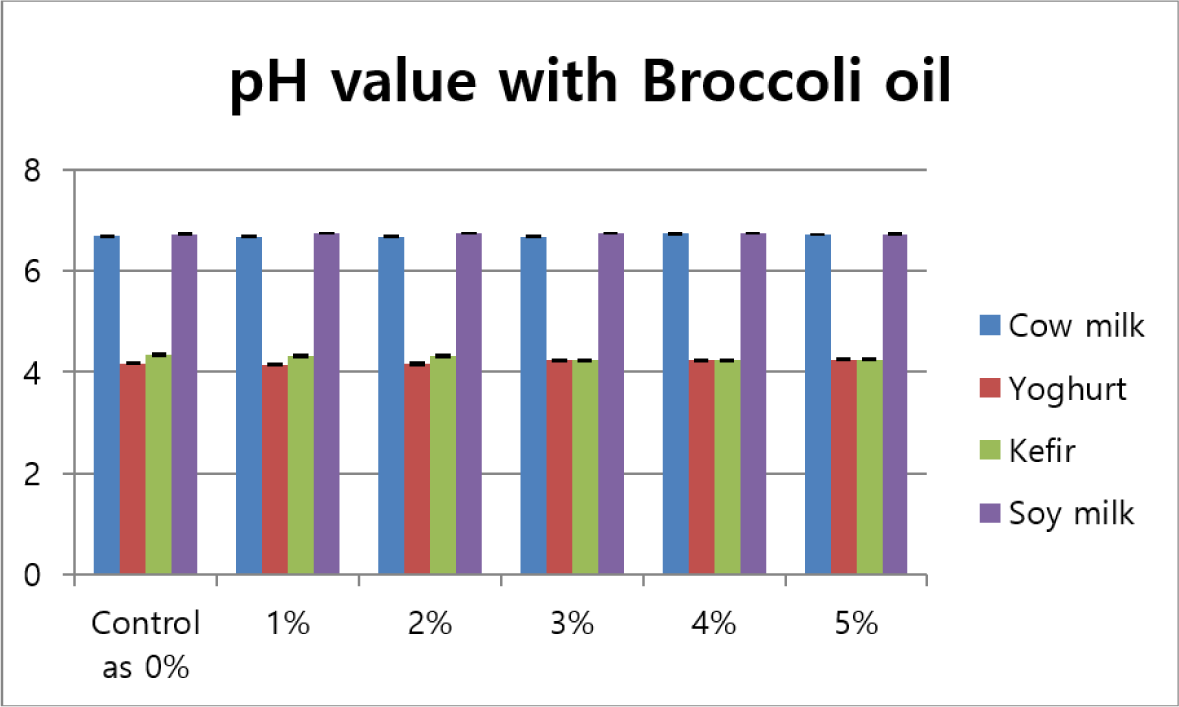
Comparing with the results of studies with the addition of other oils, it was found that the addition of oil had little effect on the change in the value of pH [11]. The value of pH obtained in this study also showed a similar trend to the results of various previous studies.
Fig. 3 demonstrated the profiles of organoleptic properties of cow milk analyzed by seven panels. Cow milk was added with different concentrations (control as 0%, 1%, 2%, 3%, 4%, and 5%) of broccoli oil. When broccoli oil was added to cow milk from 1% to 5%, the value of texture ranged from 5.0 to 3.7, the value of color ranged from 3.7 to 1.5, the value of flavor ranged from 2.8 to 1.2, and the value of overall acceptability ranged from 3.5 to 1.0, which was generally lower than 5.0 of the control group (Fig. 3).
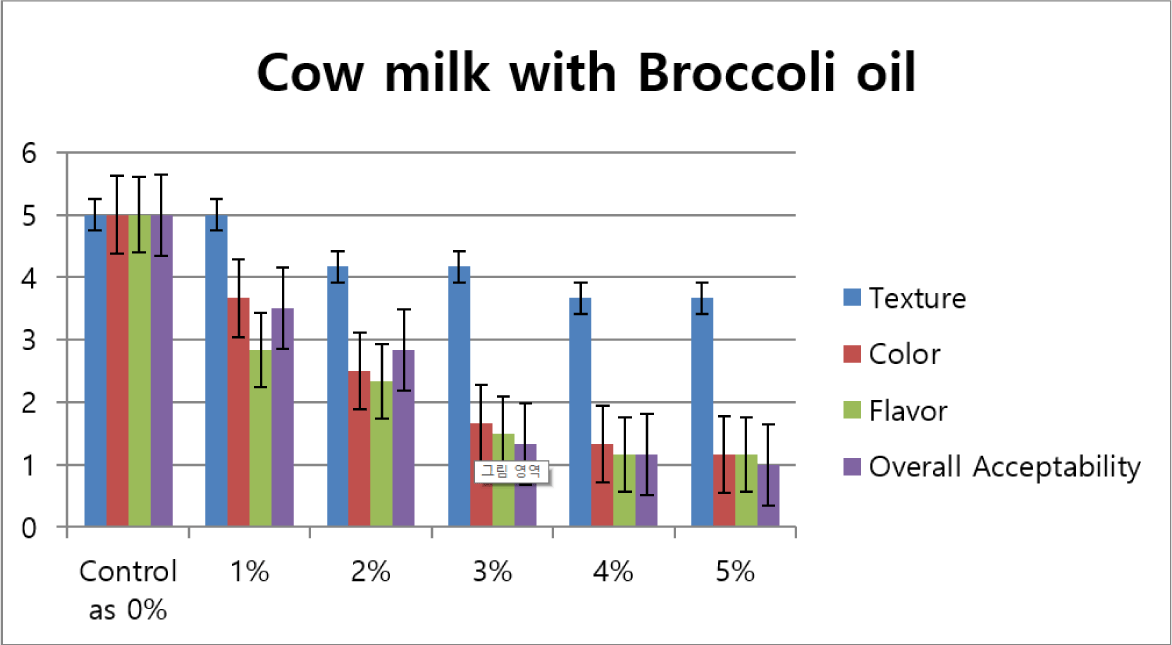
Based on the statistical evaluation of the organoleptic properties of cow milk obtained in this study, the statistically significant difference was observed between the treated group and the control group in texture, color, flavor, and overall acceptability (p<0.05). When the addition amount of broccoli oil was increased, the value of organoleptic properties of texture, color, flavor, and overall acceptability tended to decrease (Fig. 3). Namely, in this study, the cow milk added with 1% of broccoli oil showed the best results compared with control group.
Fig. 4 demonstrated the profiles of organoleptic properties of yoghurt analyzed by seven panels. Yoghurt was added with different concentrations (control as 0%, 1%, 2%, 3%, 4%, and 5%) of broccoli oil. When broccoli oil was added to yoghurt from 1% to 5%, the value of texture ranged from 5.0 to 4.8, the value of color ranged from 4.7 to 2.3, the value of flavor ranged from 4.5 to 1.7, and the value of overall acceptability ranged from 4.3 to 1.8, which was generally lower than 5.0 of the control group (Fig. 4). But, the value of texture was very similar to that of the control group, and there was no statistically significant difference.
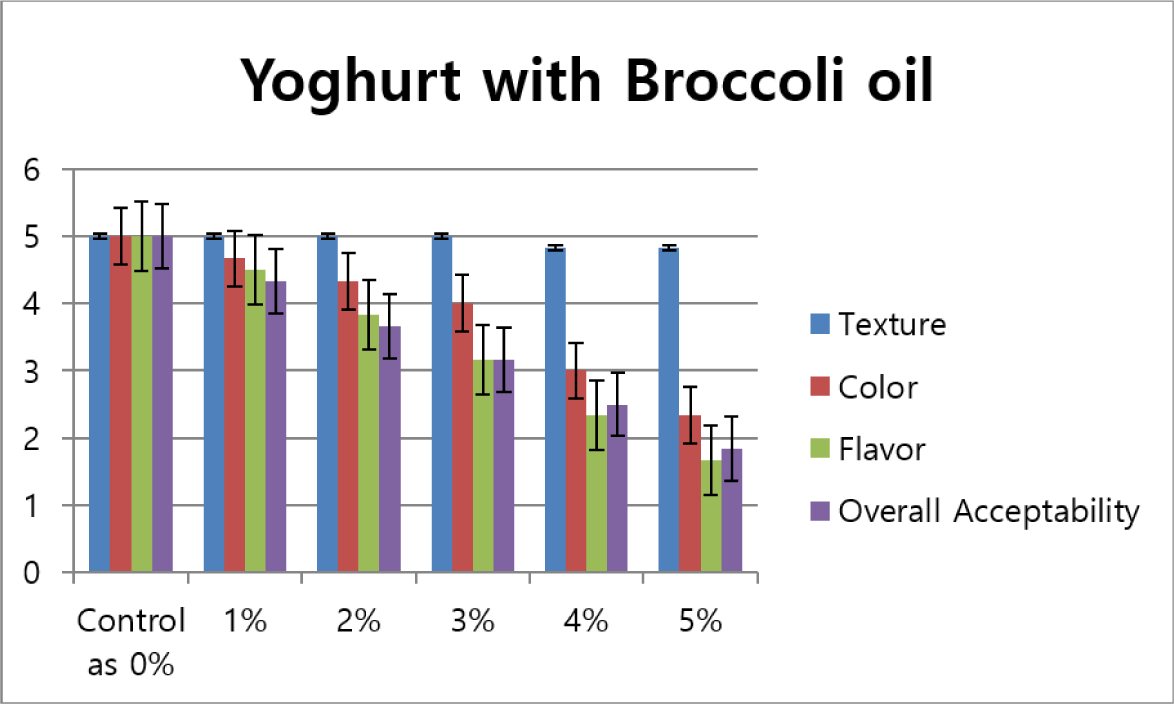
Based on the statistical evaluation of the organoleptic properties of yoghurt obtained in this study, the statistically significant difference was observed between the treated group and the control group in color, flavor, and overall acceptability except texture (p<0.05). When the addition amount of broccoli oil was increased, the value of organoleptic properties of color, flavor, and overall acceptability tended to decrease except texture (Fig. 4). Namely, in this study, the yoghurt added with 1% of broccoli oil showed the best results compared with control group.
Fig. 5 demonstrated the profiles of organoleptic properties of Kefir analyzed by seven panels. Kefir was added with different concentrations (control as 0%, 1%, 2%, 3%, 4%, and 5%) of broccoli oil. When broccoli oil was added to kefir from 1% to 5%, the value of texture ranged from 5.0 to 4.7, the value of color ranged from 4.3 to 2.7, the value of flavor ranged from 4.5 to 2.3, and the value of overall acceptability ranged from 4.8 to 2.7, which was lower than 5 of the control group (Fig. 5). But, the value of texture was very similar to that of the control group, and there was no statistically significant difference.
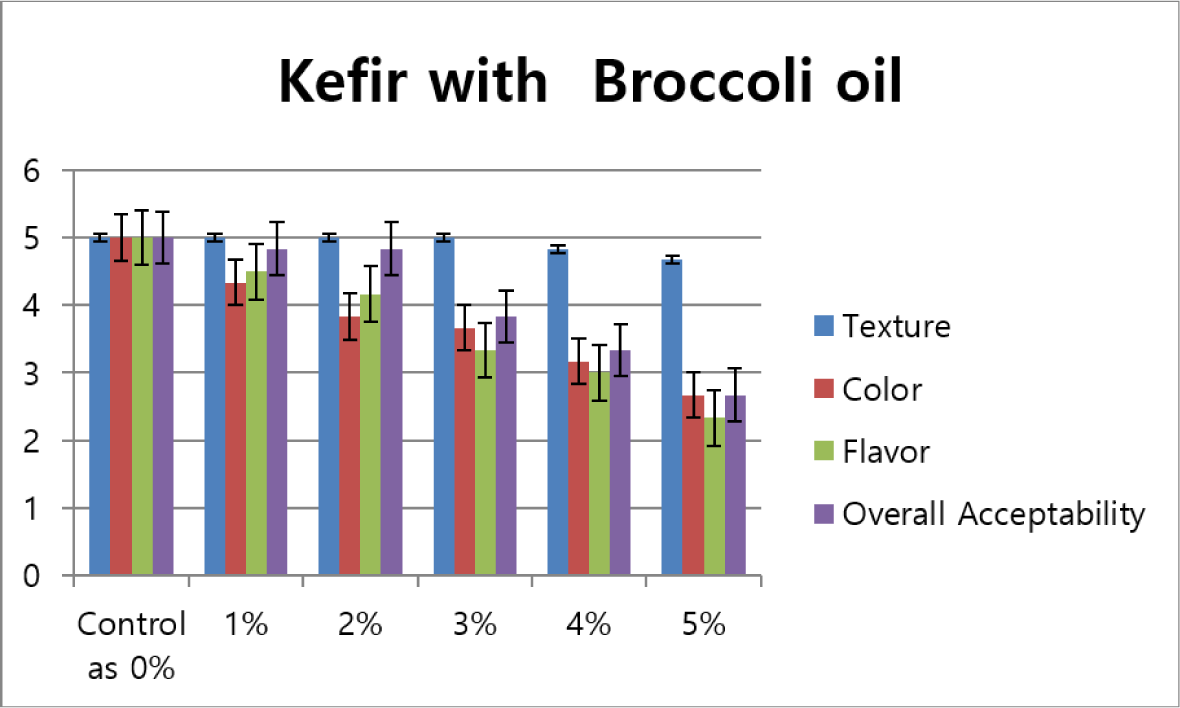
Based on the statistical evaluation of the organoleptic properties of Kefir obtained in this study, the statistically significant difference was observed between the treated group and the control group in color, flavor, and overall acceptability except texture (p<0.05). When the addition amount of broccoli oil was increased, the value of organoleptic properties of color, flavor, and overall acceptability tended to decrease except texture (Fig. 5). Namely, in this study, the Kefir added with 1% of broccoli oil showed the best results compared with control group.
Fig. 6 demonstrated the profiles of organoleptic properties of soy milk analyzed by seven panels. Soy milk was added with different concentrations (control as 0%, 1%, 2%, 3%, 4%, and 5%) of broccoli oil. When broccoli oil was added to soy milk from 1% to 5%, the value of texture ranged from 4.8 to 4.3, the value of color ranged from 4.5 to 1.7, the value of flavor ranged from 4.7 to 1.8, and the value of overall acceptability ranged from 4.8 to 1.5, which was lower than 5 of the control group (Fig. 6).
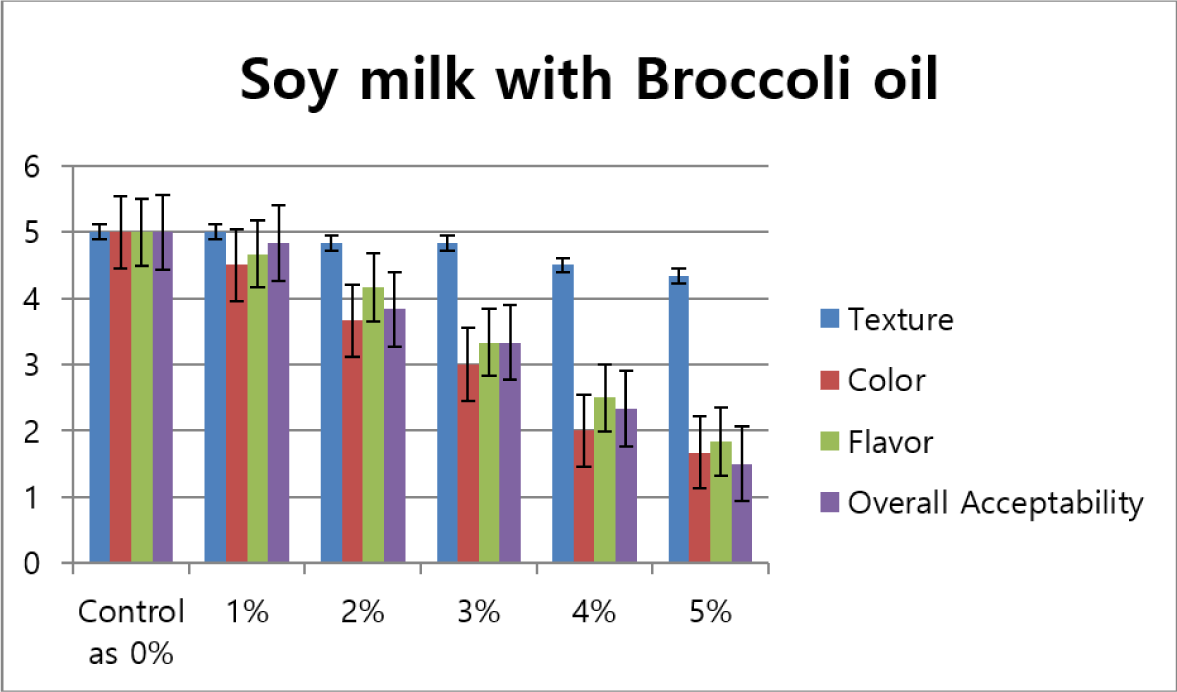
Based on the statistical evaluation of the organoleptic properties of soy milk obtained in this study, the statistically significant difference was observed between the treated group and the control group in texture, color, flavor, and overall acceptability (p<0.05). When the addition amount of broccoli oil was increased, the value of organoleptic properties of texture, color, flavor, and overall acceptability tended to decrease (Fig. 6). Namely, in this study, the soy milk added with 1% of broccoli oil showed the best results compared with control group.
Also, Fig. 7 showed the process of color change in cow milk, yoghurt, Kefir, and soy milk added with different concentrations of broccoli oil. In this study, cow milk, yoghurt, Kefir, and soy milk added with different concentrations (control as 0%, 1%, 2%, 3%, 4%, and 5%) of broccoli oil were observed to change to a bright yellow color (Fig. 7). Hence, in the organoleptic properties of cow milk, yoghurt, Kefir, and soy milk to which broccoli oil was added, the value of color showed a tendency to decrease (Fig. 3-6). In this study, broccoli oil was added without the aid of an emulsifier. Therefore, although some oil layer separation was observed in some samples, there was a general tendency to mix well (Fig. 7). However, further research is needed to improve it.
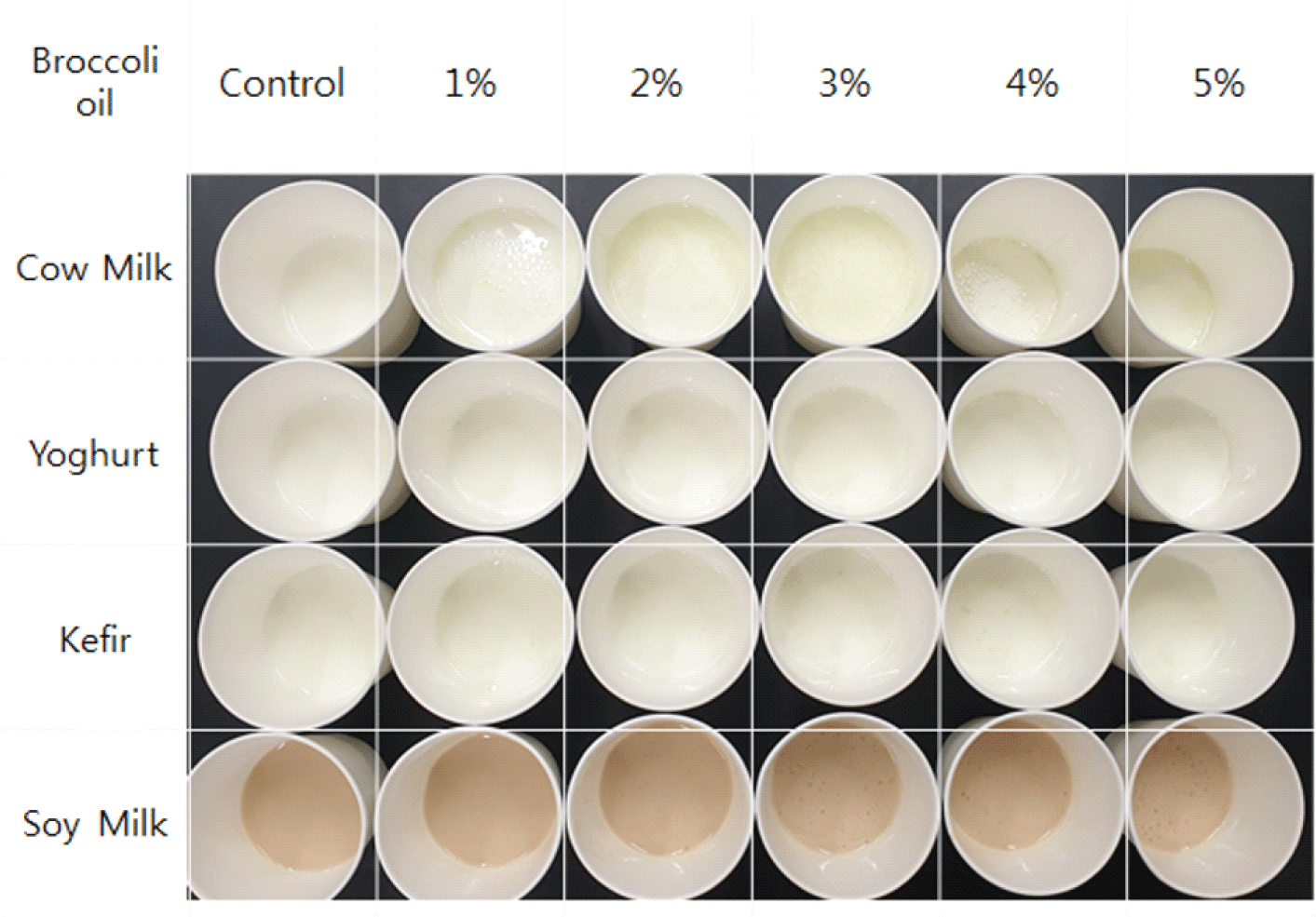
According to the report of Duque-Buitrago et al. [12], gastritis caused by a wide variety of factors was an acute and(or) chronic inflammation of the gastric mucosa. Hence, current research on the development of an effective alternative treatment for gastritis using food or food-based products is being conducted extensively. For example, there were several studies to evaluate the effect on gastritis by adding oil, broccoli sprouts, probiotics, garlic, honey to various foods such as yogurt, cheese, juice, and so on [12]. And Najgebauer-Lejko et al. [13] reported various sensory test results after adding (10% w/w) four different vegetables including broccoli to milk products fermented with DVS yogurt. In particular, the value of texture was not affected by the addition of various vegetables. What was particularly noteworthy was that the flavor was good with the addition of broccoli [13]. In this study, fermented products such as yogurt and kefir showed better flavor than other products when broccoli oil was added.
Furthermore, the broccoli sprout extract showed remarkable antibacterial activity against Bacillus subtilis, Escherichia coli. Salmonella Typhimurium, Staphylococcus aureus, and so on [5]. Therefore, these results reaffirmed the potential of broccoli sprouts as a food source that could be used in various health-related functional food industries [5,12-15]. In our preliminary experiment, broccoli oil also showed antibacterial activity against Cronobacter sakazkaii (data not shown), and additional research is currently underway.
Namely, the various beneficial effects of broccoli belonging to the genus Brassica vegetable on human health include the alleviation of the proliferation of cancer cells, the decrease of cancer risk, the induction of detoxifying enzymes, the prevention of malignant and carcinogenic mutations, the prohibition of oxidative stress, and the promotion the immune system, and also was particularly closely related to phytochemicals [14-18].
However, few studies have been found on broccoli oil. Therefore, research on adding broccoli oil with various functions to various foods should be conducted.
In conclusion, the results obtained in this study are summarized as follows. When the concentration of broccoli oil was increased and added to cow milk, the unique green flavor of broccoli oil and the flavor of cow milk were expressed separately, so the harmony between cow milk and broccoli oil did not show a good trend. However, the compatibility between yoghurt and broccoli oil showed a rather good tendency and gave a fresh feeling. Kefir also showed the same results as yogurt. In particular, it was confirmed that kefir’s unique flavor and the fresh green flavor of broccoli oil were harmonized to give overall good flavor and unique characteristics, thereby increasing the palatability. Also, it was confirmed that the balance with soymilk was good.
In other words, it is true that the flavor balance of broccoli oil is not good when it is added to the product due to the strong overall green flavor. For this reason, it is not easy to apply broccoli oil directly to a variety of dairy and nondairy products. However, considering the various nutritional and abundant physiologically active functions of broccoli oil, various studies on the use of broccoli oil should be conducted in the future. Among them, research on technology development that could control the unique herbal flavor of broccoli oil added to various foods is required first. Furthermore, additional research should be conducted through the measurement of physical properties using a viscometer and also the measurement of color using a colorimeter.
